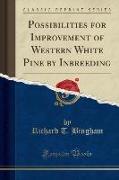Possibilities for Improvement of Western White Pine by Inbreeding (Classic Reprint)
BücherAngebote / Angebote:
Excerpt from Possibilities for Improvement of Western White Pine by InbreedingThe next oldest material is that of orr-ewing (1954, 1965, Self-pollinations of Douglas-fir (pseudotsuga menziesii (mirb.) Franco) parental trees were begun in 1952, and continued through 1968. Within 8 to 10 years about one - third of the 81 trees in seven out of eight 81 families (1 to 98 trees per line) were producing an average of, 10 to 14 female strobili per tree (orr - Ewing In the same time, sl's in only three of the eight families produced male strobili. Amounts of pollen ranged from inadequate for a single pollination to enough for four or more pollinations. Outcrossed sibs of the same parent trees had almost twice as many sporophylls per male strobilus, but pollens of 8l's or outcrossed sibs were indistinguishable. Orr-ewing (1965) went on to show that on the average about half of the filled 82 seed germinated (here in eight 82 lines), and finally, that the average first - year height of S2 seedlings in six lines varied between 27 and 59 mm. Many 81 backcrosses, 81 sib crosses, and two single crosses were also reported upon. Cone and seed yields of the 82 and these crosses also are given in Discussion, starting on page 12. Orr-ewing (1969) reinforced his earlier finding of variability in average height of 1-year - old 82 seedling families (range 79 to 158 mm). His general conclusions (orr-ewing 1954, 1965, 1969) were that in Douglas fir, inbreeding would be sufficiently rapid and easy to be entirely feasible, and that variation in inbreds was great enough so that an inbreeding program probably would be rewarding. Some of the single-cross progenies looked quite promising, and selection among sl's would have had pronounced effects on single cross seedlings. Unfortunately, no control (outcrossed) seedlings were compared with the single cross seedlings.The youngest material reported upon is that of Katsuta who began selfing Japanese black pine (pinus thunbergiana Franco) and the Japanese red pine (pinus densiflora Sieb. And Zucc.) in 1956, Within 7 to 8 years, SI trees of Japanese black pine were fruiting so that 82's and 81 sib crosses, 81 backcrosses, and single crosses could be attempted. Cone and seed yield from these second - generation inbred crossings also are given in Discussion, starting on page 12. Apparently second-generation in bred seeds were not sown. Katsuta remarked that S2 seed yields were considerably high.About the PublisherForgotten Books publishes hundreds of thousands of rare and classic books. Find more at www.forgottenbooks.comThis book is a reproduction of an important historical work. Forgotten Books uses state-of-the-art technology to digitally reconstruct the work, preserving the original format whilst repairing imperfections present in the aged copy. In rare cases, an imperfection in the original, such as a blemish or missing page, may be replicated in our edition. We do, however, repair the vast majority of imperfections successfully, any imperfections that remain are intentionally left to preserve the state of such historical works.
Folgt in ca. 5 Arbeitstagen
